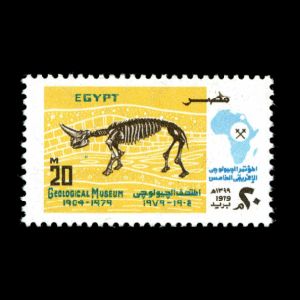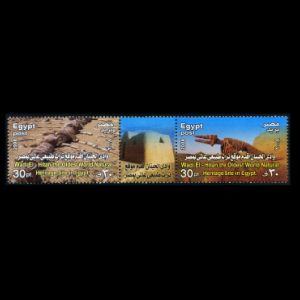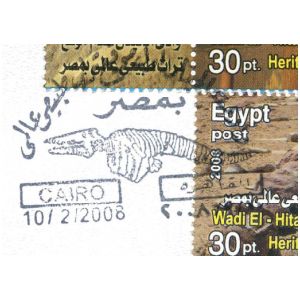the place where Paleontology and Paleoanthropology meets Philately
Egypt
Fossils on stamps and postmarks of Egypt
| << previous country | back to index | next country >> |
Contents:
- Country overview
- Philately of Egypt
- Official stamps of Egypt related to Paleontology
- Commemorative postmarks of Egypt related to Paleontology
- References
- Acknowledgements
Egypt, officially the Arab Republic of Egypt, is a transcontinental country spanning the northeast corner of Africa and southwest corner of Asia, via a land bridge formed by the Sinai Peninsula.
It is the world's only contiguous Eurafrasian nation.
Most of Egypt's territory of 1,010,408 square kilometers lies within the Nile Valley. Egypt is a Mediterranean country.
It is bordered by the Gaza Strip and Israel to the northeast, the Gulf of Aqaba to the east, the Red Sea to the east and south, Sudan to the south and Libya to the west.
Egypt has one of the longest histories of any modern country, arising in the tenth millennium BC as one of the world's first nation states.
Considered a cradle of civilization, Ancient Egypt experienced some of the earliest developments of writing, agriculture, urbanization, organized religion and central government.
The first Egyptian stamps were issued on 1 January 1866. The second issue, in August 1867, depicting the Sphinx and Pyramids.
These were the first stamps in the world depicting a historical subject. All Egyptian stamps up to 1914 used the Sphinx and Pyramids in their design.
Interesting fact:
The limestone blocks that the pyramids are made of mostly consist of nummulitic limestones –
limestones consisting of the skeletons of Nummulites (a type of foraminifera that lived during the Eocene).
Nummulites were single-celled organisms – but they were incredibly large – 4-5 cm in diameter! [R3]
Their shells were disc-shaped and ornate, as shown on Slovenian stamp in 1993
(MiNr.: 50, Scott: 172).
Egypt joined the UPU in 1875. British, French, Italian, Austrian, Russian and Greek post offices operated on Egyptian soil, particularly in Alexandria and Port Said. British troops used special stamps inscribed BRITISH FORCES IN EGYPT or ARMY POST EGYPT. [R2]
Official stamps of Egypt related to Paleontology: fossils
| 09.10.1979 "100th anniversary of Egyptian Geological Museum" | 10.02.2008 "Environment Day - Wadi El-Hitan the oldest world Natural Heritage Site in Egypt" [1] | |
 |
 |
 |
Notes:
[1] The strip of two stamps and a label in the middle shows whale fossils of Wadi (valley) El-Hitan the oldest world Natural Heritage Site in Egypt. It was designated a UNESCO World Heritage Site in July 2005 for its hundreds of fossils of some of the earliest forms of whale, the Archaeoceti (a now extinct sub-order of whales). There are at least two color variations as shown below.

Commemorative postmarks of El Salvador related to Paleontology: fossils
Legend is here| 10.02.2008 "Environment Day - Wadi El-Hitan the oldest world Natural Heritage Site in Egypt" [FDC] | ||
 |
|
|
References:
- [R1] Egypt: Wikipedia, WikiTravel, FlagCounter.
- [R2] Postal History and Philately of Egypt:
Wikipedia,
Links to official website of the Post Authority, stamp catalog and a list of new stamps of Egypt are here. - [R3] Pyramids, forams, and Red Sea reefs: Field notes from Lorraine Casazza: ucmp.berkeley.edu.
Acknowledgements:
Many thanks to Dr. Peter Voice from Department of Geological and Environmental Sciences, Western Michigan University, for reviewing the draft page and his very valuable comments.
| << previous country | back to index | next country >> |